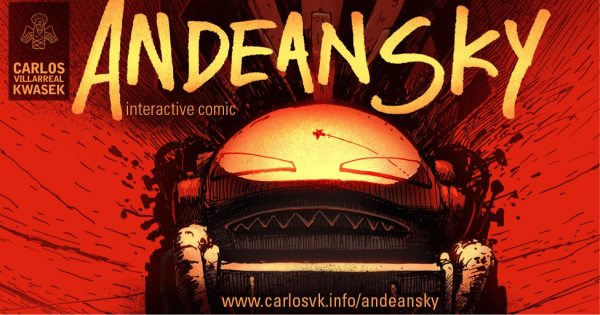Andean Sky is an inspirational web comic. It tells the story of an immigrant who returned to his hometown in Ecuador to reconnect with his own culture in the 26th Century. In this comic, the importance of identity, language, family ties, religion and technology are addressed, using a futuristic view of Ecuador and Latin America. As the creative collaboration of graphic designer Carlos Villarreal Kwasek and music composer Oliver Getz Rodahl, Andean Sky integrates interactive visuals and sound tracks. In this two-part interview, both these creators are asked about their lives, artistic backgrounds and challenges in accomplishing this beautiful, worldwide free access web project. These interviews were the result of a class project coordinated and edited by Juan Carlos Grijalva, Associate Professor of Latin American Literature at Assumption College, in Worcester, Massachusetts.
For this first part, Villarreal Kwasek is interviewed by Ambar K. Rosas Sánchez, Katelyn Coyle, Renee Zahigian, Brenda Anaya and Pamela Rios. Villarreal Kwasek is a globetrotter. He has studied in Quito, Vancouver and London, but is currently working in Stockholm. In 2002, he graduated with a double bachelor’s degree in graphic design and multimedia from the University of San Francisco de Quito. In 2006, Villarreal Kwasek completed a diploma in visual effects and character animation at the Vancouver Film School. Shortly after, he migrated to London where he worked as character animator in advertisement and film, and also as a game developer. In 2016, he completed a masters in Illustration at the University of Hertfordshire. Throughout his career as a designer, animator and illustrator, Villarreal Kwasek has completed various projects such as El Condor Ciego, Atrapados, Climber, G-force, Vancouver 2010, Golden Eye 007, Dead Space Extraction, among others. Andean Sky is available for free here.
Carlos Villarreal Kwasek
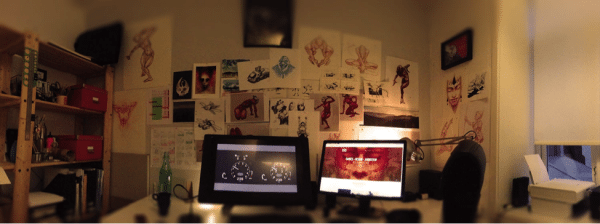

I think my parents really were my biggest inspiration
I come from a family of artists so I would say that my parents are responsible, in a big way. I started studying fine arts actually, and right after my first year, I got interested in graphic design. Just looking at what my father was teaching because they both teach in a university. When I was at the university, I actually got interested in multimedia and that’s how I ended up doing multimedia, which is 3-D animation and other skills. I think my parents really were my biggest inspiration. They never pushed me to do anything or told me you can or you can’t do this or that. They just let me be free, basically, and I think that was their greatest support for me, just letting me do what I feel like I wanted to do.
Feeling it on my own skin was the basis of my project of Andean Sky
Living abroad, it doesn’t matter where you’re from, it’s always a great experience. You learn, you open your mind. Being an immigrant and feeling it on my own skin was the basis of my project of Andean Sky. Both of my parents are immigrants. My father is from Ecuador and he immigrated to Poland. He lived there for a decade or so. Then they went back to Ecuador and then my mom became an immigrant. They both know what being an immigrant feels. I don’t think I would have been able to do that project if I wasn’t an immigrant myself. Although, I was technically an immigrant in Ecuador but I lived there so long that I became Ecuadorian, so it wasn’t exactly the same. The other part of working in different places is that, at least myself, I was very lucky to work with great people, great artists, good people. It’s almost like going to a university again. You learn so much from you colleagues. You gain so much more knowledge by just working with these people.
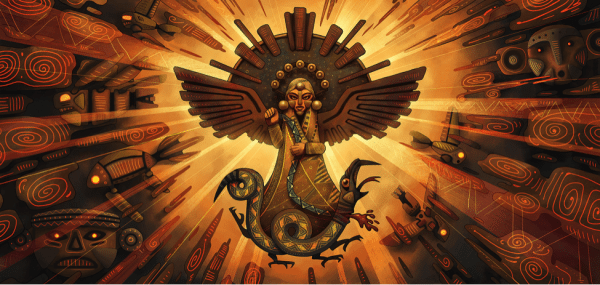

The most challenging thing is becoming a freelancer
Breaking into the industry. Like going from being a student into working on a real project. I think that was difficult and it took many years. I think that’s probably something that other people may identify with. It just takes time for you to build your network, to get the right job, to be lucky, to have the opportunities show up on your desk. So I think that was an obstacle that I guess many people would face. I think the most challenging thing that I have done recently is becoming a freelancer. Because since the beginning, I always worked for someone, for a company or an institution. I was always working from “nine to six”, had a steady pay check and had the stability of a steady job.
When I moved to Norway I decided to open my own company and I became an independent freelancer. That was difficult not only from the artistic side but overall, how my life changed because of that. It was definitely educational and I feel like it enriched me because I ended up doing things that I wouldn’t have done otherwise. For example, accounting. I do my accounting myself so I had to learn the system in Norway and get up to speed about how things work. When you try something different it’s challenging but once you get it, I think you can enjoy it. And I think, from where I’m standing now, I am glad I did that because it makes you a richer person. And I have to say, coming from a liberal arts type of education, I’m glad I was exposed to trying different things. It all somehow enriches your art if you are an artist.
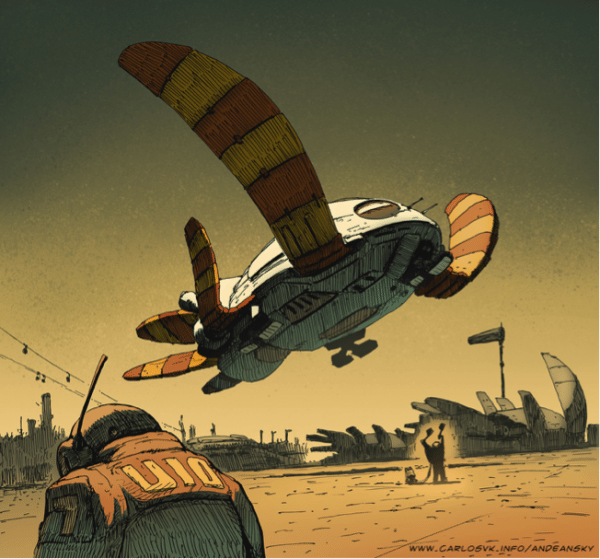

I realized I like motion graphics
My goal was to continue working with films and I was mainly focused on character animation. I was also looking for more variety in my portfolio. A lot of people have done games so, I wanted to try games. And I did that. I went to a game company and did some character animation there. I was also able to help with other projects and utilize other skills. I’m glad that happened because when I was doing a game called Golden Eye 007, which is a James Bond game. I did a lot of motion graphics, and I realized that I like more the animation combined with graphic design, which we call motion graphics, than character animation. I realized that my heart was there. It wasn’t just character animation, it was more like this new thing that I was getting cozy with. And that in turn lead me into user interface and concept development. These skills were a continuation of my work as a designer. I guess it was a little bit of a chance. I’m glad it happened because it changed my perspective on where I wanted to take my work.
I don’t think I know what my art style is
I don’t think I know what my art style is. I think I am trying to find that myself but I’m also trying to avoid it at the same time. Because I think it is not good to be stuck in one thing for too long or forever. So in that regard I don’t think I want to just be left with one thing and not do anything else. But, what I can tell you is what I am interested in. More than anything, at least in my illustration work, I am interested in story telling. I want to create images that convey and speak to an audience. I think that wherever media might it be, that is my ultimate goal as an artist.
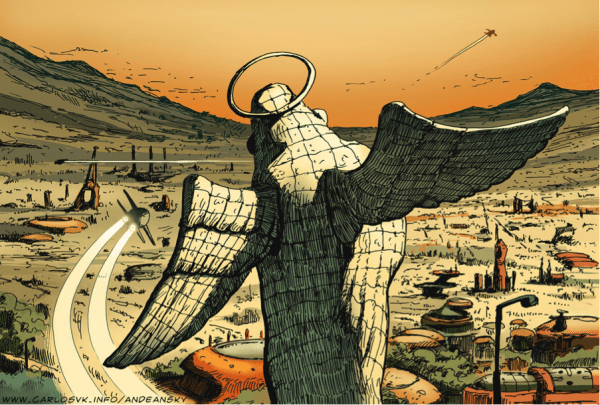

As an artist, you are constantly inspired by different things, different artists, different styles, different time periods. I would like to point out my inspiration for Andean Sky… I would say Star Wars was a big inspiration for me. Not just for Andean Sky, but for my love of science fiction. I grew up watching Star Wars over and over. It was one of those things you see as a kid that eventually just ends up influencing your work years later. I would also mention Myst, the game Myst, is a series of games. It’s an adventure game. I think it is the first adventure game I played and the first experience that I felt immersed. That really left a mark. The studio that created Myst is called Cyan. That was a huge inspiration for me that also got me interested in games. I wanted to create something so immersive like this game. With music, gameplay, nostalgia and storytelling. It has so many different elements combined. That was not only my inspiration for Andean Sky, but a lot of my work throughout my career, actually.
That was the seed where Andean Sky was born
Ten years ago, Eduardo Villacis, my mentor, and later, my colleague, was doing a project called Pretéritos Futuros. He developed it and it is still going on. It is a collaborative project where the premise was: how Ecuador would look like in 500 years? Eduardo’s starting point is always parody and humor. I collaborated with a couple of images and those images happened to be this bus, a flying bus. I thought “Ecuador in the future is going to look really modern. It’s going to have this modern style, but the buses are still going to look like —you know— hanging and have its own folklore to it.” That was the seed where Andean Sky was born. It’s been a couple of years that I’ve thought about this [project]. Eventually in 2012, I came back to the concept and continued sketching vehicles for the future. At that point, I realized that I wanted to do something with this and that it wasn’t within the scope of Pretéritos Futuros. I wanted something for myself. And that’s when I realized I had to create a whole universe. I need to design how Ecuador is going to look like in the future from the ground up. How people are going to look like, the society etc.


It was a couple years that I started thinking how I could develop this. And that’s what lead me to do my master’s degree at the Interactive Design Institute. I realized that I didn’t have the tools to conduct research for this project. I didn’t had the academic background for that. So I looked for a master’s degree to actually learn those skills. That’s exactly what I got from the master’s degree. I learned how to research for this project and how to shape this concept from the theoretical perspective and the visual as well.
While I was doing the master’s, I think that the first collaboration was with my thesis mentor: Christopher Gibbs. He was overlooking my studies. A second collaboration, which was outside the university, was with Oliver Rodahl Getz, a sound designer and composer. A very much appreciated collaboration. I was in Oslo presenting a project to a social group —a game developer meetup— when Andean Sky was still an idea. A couple of sketches and not much more than that. Oliver came up to me after my presentation and offered to do the sound. I was really lucky to have found him, that he found me, because he really created 50% of the experience. I work with images and I know that audio makes half of the impact, looking at the image is part of the experience but experiencing it with sound makes the project whole. I think that Oliver really made the project whole. I was very fortunate and lucky for that.
I think that my creative process is a bit chaotic
I think that the creative process is a bit chaotic—at least mine is very chaotic. That’s why I like to structure my development as much as I can. So, what that means is that I try to create clusters of space and time where I can be free and chaotic to brainstorm. After that, I would have a period of time where I can organize and put these ideas in order. Really, it’s to create a schedule where I can see how things move from one stage to the next one. That’s how I try to organize my creative process and still have some freedom to just wander. And for Andean Sky, I was a little bit overwhelmed after my research about how many topics I wanted to attack. At some point, I felt like I couldn’t complete this project because I was going to try to say too many things in too little space. I decided to use a method that is often used in marketing for games. It consists of creating a phrase that describes the pillars of the project. It’s just a sentence that contains key words that synthesize what the project is about.
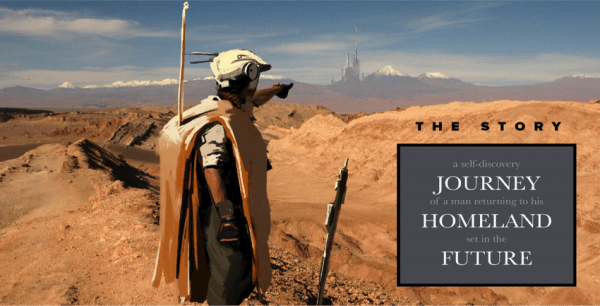

This sentence might change a little bit as you develop the project, but this sentence helps you to focus your research. Every effort that you make, every sketch that you make, everything you create has to support this sentence—or, as it is called, the pillars of the project. If it doesn’t support the pillars, then it means it isn’t supposed to be there; it means that maybe you aren’t spending your time well. For instance, I had the word “future” in this sentence. With that, I was justifying my research into science fiction, into future, and the future of Ecuador.
I sometimes get it wrong, haha. [pause] OK, there we go. The sentence is this: “A self-discovery journey of a man returning to his homeland set in the future.” If we speak about journey, journey could be presented in different ways, but when you combine it with the other words that are there, you can start making sense of the kind of journey we are speaking about.
At the beginning I didn’t think it was going to be a comic
I would say it took a bit less than two years. I think the longest part was the research or the pre-production as I like to call it. That’s when you are trying to find what exactly you want to do and what the project is about, but also what technique you are going to use or if it is going to be a comic at all. At the beginning I didn’t think it was going to be a comic, I thought it was going to be a visual diary. There is a middle step before doing the final project which is what we call in gaming, first production. It is just a demo for the project where you try out different things that you’ve been researching and put them to the test. For example, my thought process was very much like this: I want to do something interactive so let’s do one interactive page with this art style and all the things I want to do. Let’s see if it works.
I would say that this demo took about six months to complete. The demo is like a thermometer that can tell you if you can do the project the way you want to do it or if you need to optimize or change the story. You learn so much from this and I learned a lot. I needed to speed up the illustration process. Each illustration was taking me a week to complete and it needed to be done in a day. As long as you can take your development process and see things in numbers you can plan. So again, for example: it takes me this many hours to do this and that, then I can project into the future and see how many hours I will need to finish the project by a certain date. I can then change my strategy if needed.
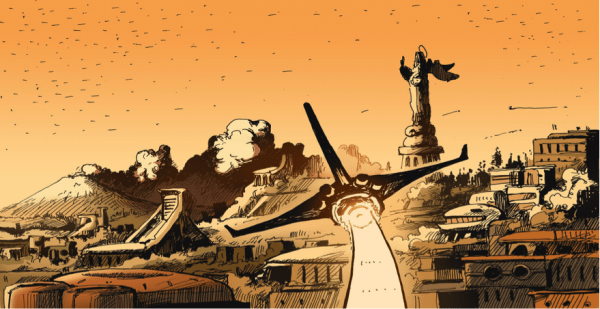

The biggest challenge for me was the layout of the page
I would say the biggest challenge for me was the layout of the page. When I started researching interactive web comics there are a lot of new propositions. I think it is a very new, very fresh format and different people have different ideas and propositions. When I saw what was out there I wanted to do something more simple for myself. I didn’t want to focus on the interactivity more than the story itself. I think that finding the minimal interactivity and still being able to read was the biggest challenge. And again going back to the demo, once I did the demo, I understood how the page worked. The bottom line is that this page is not a printed page, not a page with borders, it is limitless in a way, it goes from top to bottom. So there are certain things that once you practice you start understanding and then can start creating.
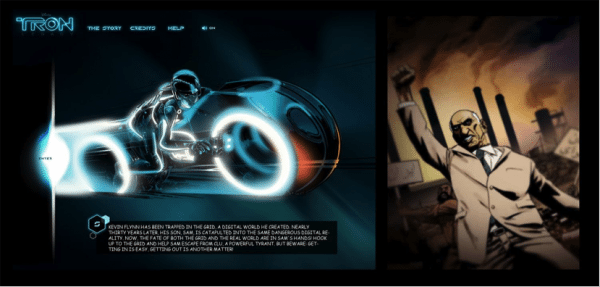

My gaming background was a bit of an influence there. When I realized I wanted to make a story I thought: what if I make a story with little games inside? Then I thought, maybe I am just getting off subject. And then I found this interactive web comic. It was really rewarding to be able to dictate the animation. I’m interested in new technology and technology in general.
When you do your homework, it is a little bit easier
I spent maybe two months doing the actual project that you see online. When I started working on the final product I knew exactly what I wanted to do and how the technology worked, because I spent good time doing the preproduction process and the demo. So it’s like when you do your homework and then you go to the final exam, it is a little bit easier.
The publishing part I think that was the easiest because I decided to have this product for free and that it would be web-based. I didn’t want to have it on the App Store or the Android Store. I didn’t want it to have the extra step that you would have to click to download it. I wanted it to be available immediately and for free. That choice allowed me to publish right away with no cost and no restrictions.
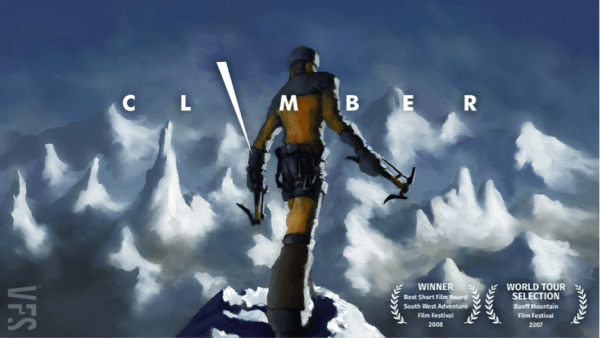

Publishing the comic is not the end line. After publishing, you need to do a little monitoring to see how people react to the product, to see if it actually works, to see if they understand the story and if they like the story. I want to continue working on this project and continue working with the story. I cannot just close myself and isolate myself from the public because eventually I do want an audience for this.
My work is autobiographical, even if it is science fiction
I would say yes it is, absolutely. It kind of became that way and it felt good to do it. It was a bit of therapy for myself as well because I’m an immigrant. I am a bit shy as a person and being able to express myself through art has always been my channel of communication. My work always has to be personal in a way or autobiographical, even if it’s science fiction. When you mentioned nostalgia I think that it has driven my work since the beginning. Even before I was an immigrant and even before I had that feeling of nostalgia towards home I do remember I have always had that feeling of nostalgia towards something. And I think now I just found a nostalgia that is more tangible, which is home or where it used to be home.
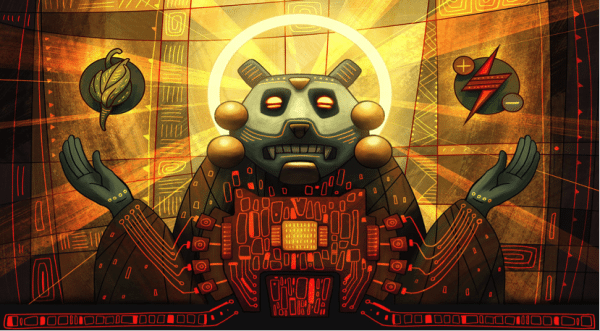

I would like to see this Ecuador in the future, at least what I have there in the comic. I would like to spend one day or one week, maybe one month, in that place, and have fun but I don’t think I would like to stay there because I would just eventually miss the Ecuador that I remember. In a certain way is a little bit how I feel now, you remember what you used to have when you were a teenager or a kid. Now when you come back and you see things different, that’s when you feel nostalgia. Change is good, I don’t think change is bad. But I think it’s good to be part of the change, so you don’t become so alienated. If I lived in a future Ecuador, 100 years from now, it would be like living in a different planet. It would definitely be fun to see.
The bigger comment here is that any culture can evolve to anything. Culture evolves and the Latin American culture has the same chance of evolving as any other. It’s a little disappointing sometimes to see that Latin America has been represented in science fiction as underdeveloped and always behind.
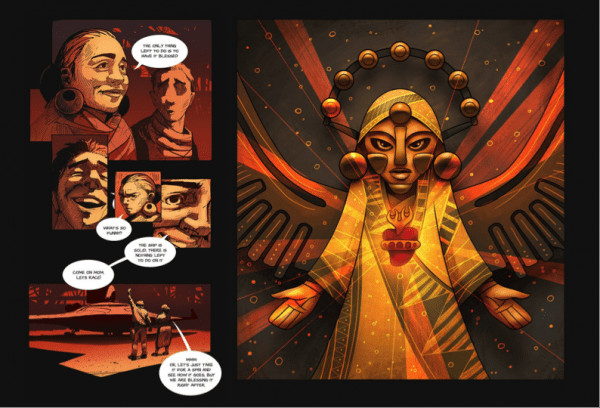

I like to see how different things come together
Being a user interface designer for video games, means that I design how people operate technology, whether it’s a website or a game. My work as a game developer influenced my project. My personal work in design influenced my concepts and my illustrations. I think I became more of a designer, meaning that I like to see designs in a broader scale now. I like to see how different things come together, like a Lego set. I think it opened my eyes a little bit, it broadened my view.
I was raised as a Christian but I personally don’t have any faith. I don’t believe in anything except, I guess, the goodness of people. The spirituality of the religion in the comic was a pragmatic choice because it helps me connect the different pieces of the culture with the actual story and it gives reason for the characters to have a conflict. From that side it’s a very pragmatic decision, why it’s so spiritual. But from another perspective, it’s also an emotional decision because it tells a little bit of my own feelings towards religion, I guess. In the process of doing the comic, I just wanted to say that you cannot say that there is no God or that there is a God. There is no proof one way or the other. It was just a little bit of a reflection. There is always going to be some sort of doubt.
***
About This Interview Project
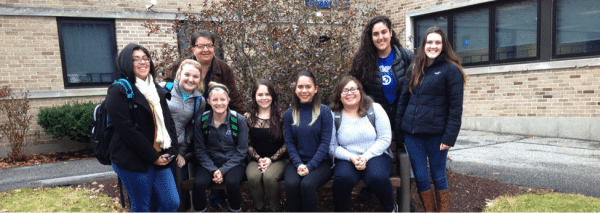

During the Fall Semester of 2016, Brenda Anaya, Hannah Avard, Katelyn Coyle, Isobelle Ives, Monique LaBarre, Ambar K. Rosas Sánchez, Pamela Rios and Renee Zahigian, students of Assumption College, interviewed graphic designer, Carlos Villarreal Kwasek, and music composer, Oliver Getz Rodahl, authors of the artistic project Andean Sky, an interactive web comic. This class project was coordinated and edited by Juan Carlos Grijalva, Associate Professor of Latin American Literature. We would like to express our gratitude to Carlos and Oliver for their trust on this project and music professor Peter Clemente and Arts and Design Professor Lynn Simmons for their support.



